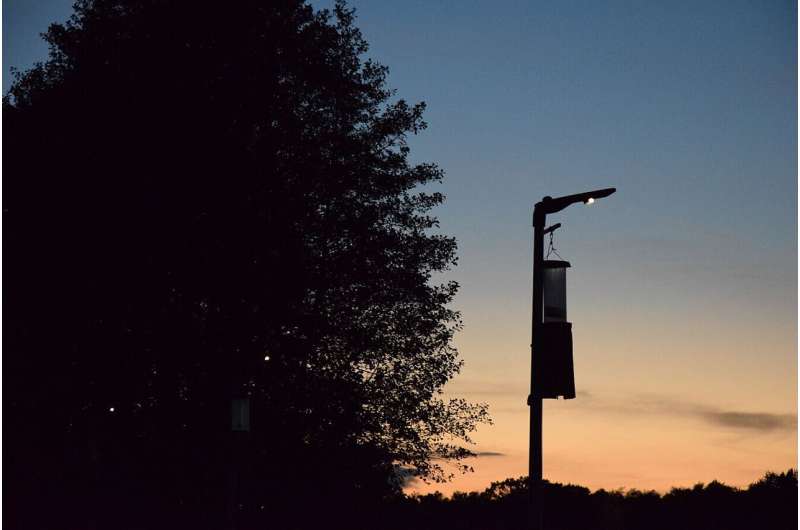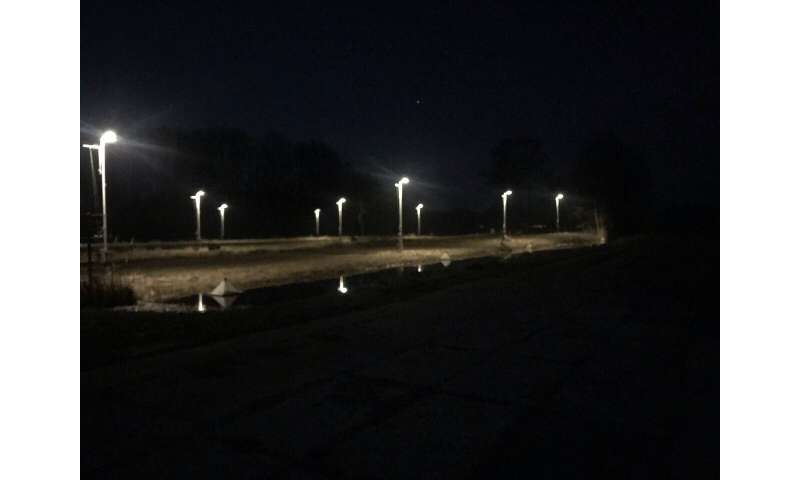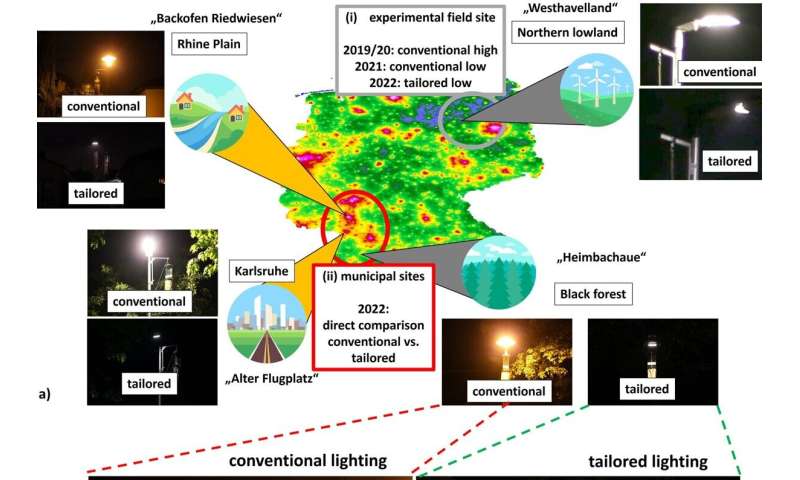
This is one of the new lights on the test field. An insect trap hangs from the lamp. Credit: Aube
In an interdisciplinary study, a research team led by the IGB has developed insect-friendly street lighting and tested it in the Westhavelland Dark Sky Reserve as well as in three German municipalities. Adapted and shielded road lights make the light source almost invisible outside the illuminated area and significantly reduce the lethal attraction for flying insects in various environments. Researchers see this as an important technical solution to reduce insect mortality.
The study was published in the journal Biology of communications.
Street lights can become a trap for insects at night: Flying insects such as moths are attracted to the lights and drawn away from their habitats (vacuum cleaner effect). Disoriented insects often circle around light sources until they die of exhaustion or are eaten.
To test insect-friendly street lighting, street lights in a field experiment in the Westhavelland Dark Sky Reserve (AuBe project) and on streets in municipalities in Baden-Württemberg along three selected nature reserves in the Rhine-Neckar, Karlsruhe and Freudenstadt districts . (NaturLicht project) were converted into a before and after experiment. The four sites were chosen to represent a wide range of environmental conditions (urban, peri-urban, rural) and existing light pollution, and to cover a large area of Germany.
Light only where needed is much better than dimming
New LED luminaires provide more focused light, reduce spill light and are shielded top and side to minimize light pollution. And they reduce insect mortality: Insect trap catches in the lights showed researchers that the number of flying insects attracted was significantly lower. As a control, previous conventional lights were used.
-

Conventional lamps emit a lot of light (pollution) in all directions. Credit: Aube
-

Experimental sites and design. Credit: Biology of communications (2024). DOI: 10.1038/s42003-024-06304-4
Surprisingly, dimming conventional lights by a factor of 5 had no significant effect on insect attraction. “We had assumed a general dose-response relationship for the flight behavior of insects in relation to artificial light. However, it turns out that reducing unwanted light emissions by means of spatial isolation and protection is much more effective than reducing illumination, ” explained the IGB researcher. Manuel Dietenberger, first author of the study.
The exact mechanism of how insects react to street lighting is not yet fully understood. It is thought that some species of insects do not fly directly towards the light for a short distance, but instead tilt their backs towards the brighter hemisphere in order to maintain flight control.
“In view of the results, we recommend the use of adapted and protected lighting to protect insects,” said Prof. Andreas Jechow from the Brandenburg University of Applied Sciences and guest scientist at the IGB.
“This should be used especially in sensitive areas such as near nature reserves, freshwater ecosystems or other areas with high biodiversity,” added Franz Hölker, head of the IGB Light Pollution and Ecophysiology research group.
More information:
Manuel Dietenberger et al, Reducing Fatal Attraction of Nocturnal Insects Using Adapted and Shielded Street Lights, Biology of communications (2024). DOI: 10.1038/s42003-024-06304-4
Provided by Forschungsverbund Berlin eV (FVB)
citation: New road lights, fewer dead bugs—bug-friendly lighting successfully tested (2024, June 13) retrieved June 14, 2024 from https://phys.org/news/2024-06-road-dead- insects-insect-friendly. html
This document is subject to copyright. Except for any fair agreement for study or private research purposes, no part may be reproduced without written permission. The content is provided for informational purposes only.